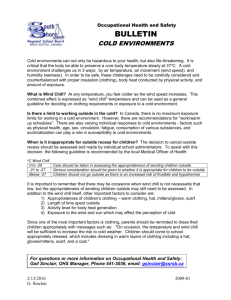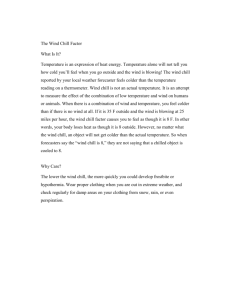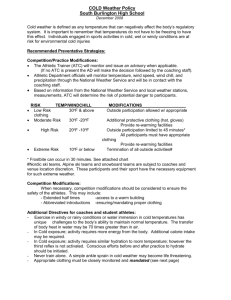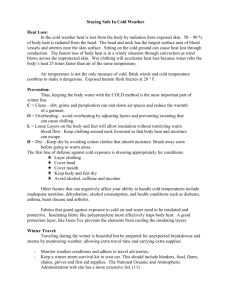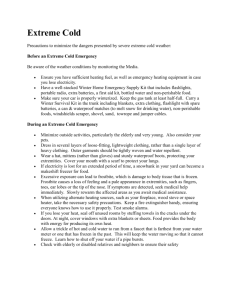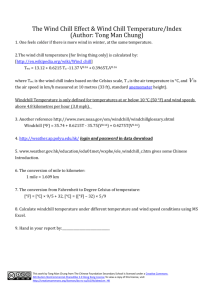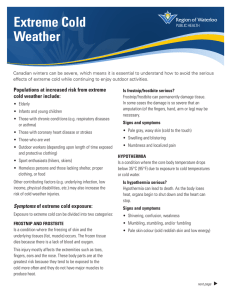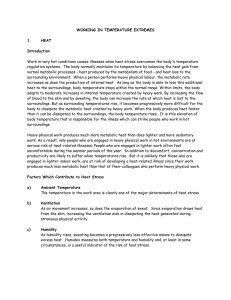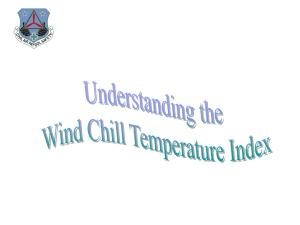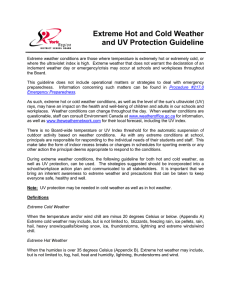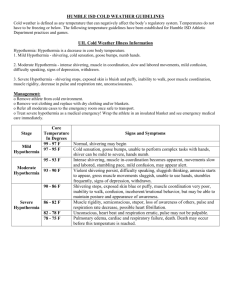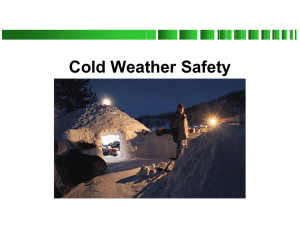Wind Chill Chart - Vermont Principal`s Association
advertisement
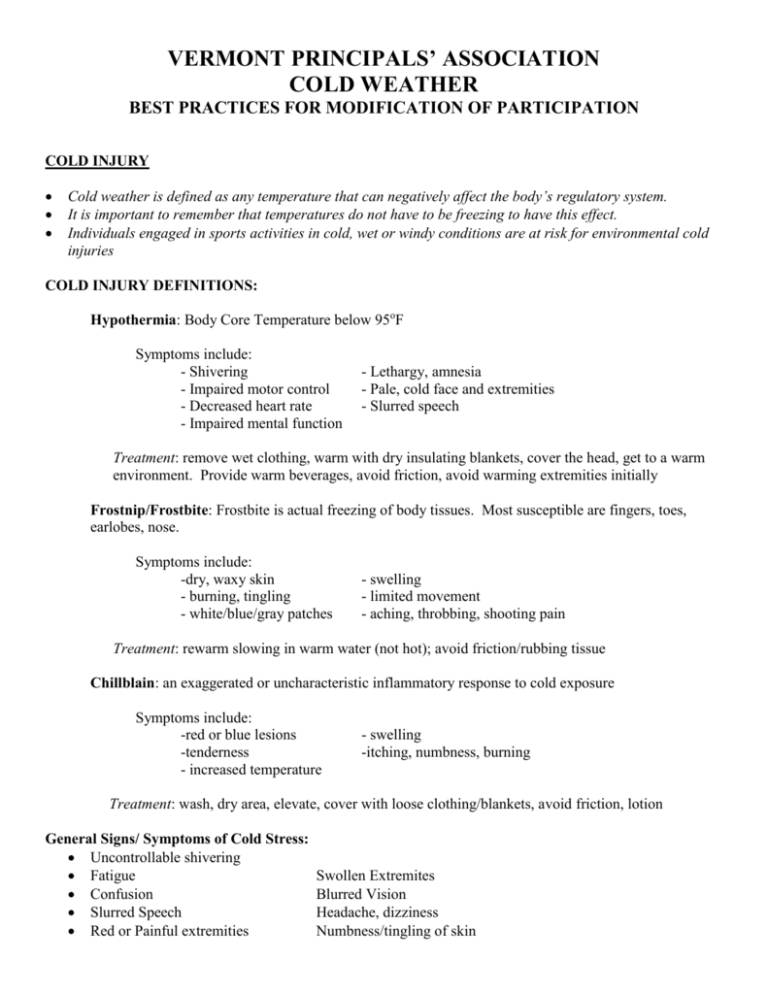
VERMONT PRINCIPALS’ ASSOCIATION COLD WEATHER BEST PRACTICES FOR MODIFICATION OF PARTICIPATION COLD INJURY Cold weather is defined as any temperature that can negatively affect the body’s regulatory system. It is important to remember that temperatures do not have to be freezing to have this effect. Individuals engaged in sports activities in cold, wet or windy conditions are at risk for environmental cold injuries COLD INJURY DEFINITIONS: Hypothermia: Body Core Temperature below 95oF Symptoms include: - Shivering - Impaired motor control - Decreased heart rate - Impaired mental function - Lethargy, amnesia - Pale, cold face and extremities - Slurred speech Treatment: remove wet clothing, warm with dry insulating blankets, cover the head, get to a warm environment. Provide warm beverages, avoid friction, avoid warming extremities initially Frostnip/Frostbite: Frostbite is actual freezing of body tissues. Most susceptible are fingers, toes, earlobes, nose. Symptoms include: -dry, waxy skin - burning, tingling - white/blue/gray patches - swelling - limited movement - aching, throbbing, shooting pain Treatment: rewarm slowing in warm water (not hot); avoid friction/rubbing tissue Chillblain: an exaggerated or uncharacteristic inflammatory response to cold exposure Symptoms include: -red or blue lesions -tenderness - increased temperature - swelling -itching, numbness, burning Treatment: wash, dry area, elevate, cover with loose clothing/blankets, avoid friction, lotion General Signs/ Symptoms of Cold Stress: Uncontrollable shivering Fatigue Confusion Slurred Speech Red or Painful extremities Swollen Extremites Blurred Vision Headache, dizziness Numbness/tingling of skin VERMONT PRINCIPALS’ ASSOCIATION COLD WEATHER BEST PRACTICES FOR MODIFICATION OF PARTICIPATION Recommended Preventative Strategies: Competition/Practice Modifications Consider extended half-times to allow for rewarming Provide access to a warm building Consider abbreviated introductions Ensuring/mandate proper clothing (hats, gloves, pants) Coaches should be vigilant and monitor player’s physical condition and mental status Clothing: In cold weather conditions appropriate clothing should be worn to prevent cold exposure. Both the Athletic Trainer(s) and coaches should require the student-athletes to implement the following: Wear several layers around the core of the body (especially those who are not very active). o The first layer should wick moisture away from the body (DryTech, underarmor) o The top layers should trap heat, block the wind (fleece, windblock) o No cotton as inside layer. o Outside layer should be water resistant/waterproof Long pants designed to insulate. o Sweatpants are a good choice. o On cold/and or windy days windpants or a nylon shell should be worn on the surface layer to break the wind. Long sleeved garment that will break the wind Gloves Hat or helmet to protect the ears Face protection Moisture wicking socks (preferably wool blend) -It is important that athletes avoid wearing multiple layers of cotton. When the body sweats the cotton will become dense and permeated with sweat Factors Affecting Body Temperature Regulation in Cold: Wind and moisture (rain) dramatically increase heat loss from the body Cold exposure/activity requires more energy from the body. Additional calorie intake may be required. Cold exposure/activity requires similar hydration to room temperature; however the thirst reflex is not activated. Conscious efforts before and after practice to hydrate should be initiated. Never train alone. A simple ankle sprain in cold weather may become life threatening. Appropriate clothing must be closely monitored and mandated (see above) VERMONT PRINCIPALS’ ASSOCIATION COLD WEATHER BEST PRACTICES FOR MODIFICATION OF PARTICIPATION STEPS FOR MONITORING COLD WEATHER: Weather should be monitored by designated athletic department personnel (if a Certified Athletic Trainer is not present) and an advisory should be issued to school coaching staff when applicable. Temperature, wind speed, and wind chill will be monitored. Athletic Department officials will use a Wind Chill Index Chart as a measurement for impending weather situations. o The Wind Chill Index considers effects of temperature and wind speed (see below) o The chart is available at: http://www.weather.com/ready/winter/wind_chill.html Based on information from the National Weather Service, local weather stations and local/on-site Cold Index measurements, determine the risk of potential danger to participants. RISK Low Risk Temp/Windchill 30oF & above MODIFICATIONS# Outside participation allowed w/appropriate clothing Moderate Risk 29oF – 20oF Mandate additional protective clothing (hat, gloves) Provide re-warming facilities High Risk 19oF – 10oF Outside participation limited to 45 minutes* All participants must have appropriate clothing Provide re-warming facilities Extreme Risk 9oF or below Termination of all outside activities # *Frostbite can occur in 30 minutes. See attached Windchill chart #Nordic ski teams, Alpine ski teams, and snowboard teams are subject to coaches and venue location discretion. These participants and the nature of their sport usually have the necessary equipment for such extreme weather. Wind Chill Chart The Wind Chill is the temperature your body feels when the air temperature is combined with the wind speed. It is based on the rate of heat loss from exposed skin caused by the effects of wind and cold. As the speed of the wind increases, it can carry heat away from your body much more quickly, causing skin temperature to drop. The Wind Chill chart below shows the difference between actual air temperature and perceived temperature, and amount of time until frostbite occurs. Temperature (?F) 60 55 50 45 40 35 30 25 20 15 10 5 -45 -98 -97 -95 -93 -91 -89 -87 -84 -81 -77 -72 -63 -40 -91 -89 -88 -86 -84 -82 -80 -78 -74 -71 -66 -57 -35 -84 -82 -81 -79 -78 -76 -73 -71 -69 -64 -59 -52 -30 -76 -75 -74 -72 -71 -69 -67 -64 -61 -58 -53 -46 -25 -69 -68 -67 -65 -64 -62 -60 -58 -55 -51 -47 -40 -20 -62 -61 -60 -58 -57 -55 -53 -51 -48 -45 -41 -34 -15 -55 -54 -52 -51 -50 -48 -46 -44 -42 -39 -35 -28 -10 -48 -46 -45 -44 -43 -41 -39 -37 -35 -32 -28 -22 -5 -40 -39 -38 -37 -36 -34 -33 -31 -29 -26 -22 -16 0 -33 -32 -31 -30 -29 -27 -26 -24 -22 -19 -16 -11 5 -26 -25 -24 -23 -22 -21 -19 -17 -15 -13 -10 -5 10 -19 -18 -17 -16 -15 -14 -12 -11 -9 -7 -4 1 15 -11 -11 -10 -9 -8 -7 -5 -4 -2 0 3 7 20 -4 -3 -3 -2 -1 0 1 3 4 6 9 13 25 3 4 4 5 6 7 8 9 11 13 15 19 30 10 11 12 12 13 14 15 16 17 19 21 25 35 17 18 19 19 20 21 22 23 24 25 27 31 Frostbite Times: 5 Minutes 10 Minutes 30 Minutes http://www.weather.com/ready/winter/wind_chill.html References: www.NATA.org/position-statements Environmental Cold Injuries VPA Sports Medicine Advisory Committee August 2011 40 25 25 26 26 27 28 28 29 30 32 34 36
